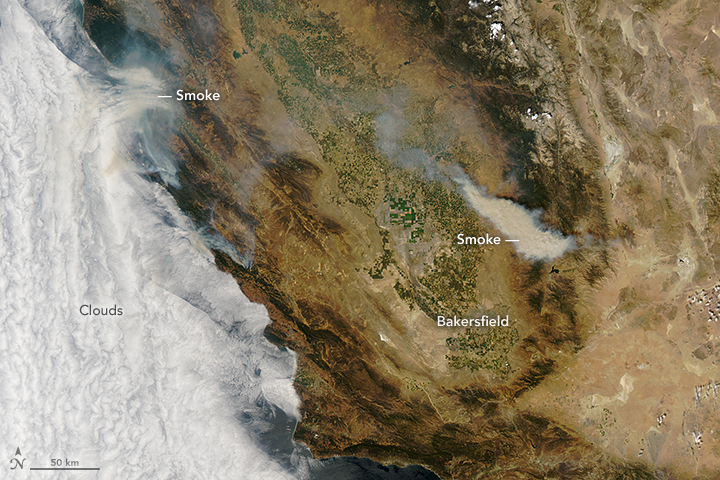

Wildfires pose a direct threat to human life and property in the western United States. According to a new study, they are likely to have a more insidious, indirect effect in the future.
As the world continues to warm with increasing greenhouse gases, a growing body of research suggests that wildfires will grow more frequent and intense. According to new findings published in Climatic Change, more wildfire activity will bring heavier smoke and more negative effects on human health. The Yale University-led study highlights the health consequences of having more smoke in the air.
The study comes as dozens of wildfires are burning across the western United States. The mosaic above and image below were acquired by the Moderate Resolution Imaging Spectroradiometer (MODIS) on NASA’s Aqua satellite on August 18, 2016. In the top image, red boxes mark the locations where MODIS detected warm surface temperatures associated with fire. Smoke plumes hang over several parts of California, Oregon, Idaho, and Washington; smoke is usually gray while clouds are brighter white. The close-up below shows the smoke pall from the Soberanes fire (upper left) and the Cedar fire (middle right) in California.

California’s Blue Cut fire drew public attention in August after it prompted 82,000 evacuations. But fires in other states have scorched hundreds of thousands of acres this year. Idaho’s Pioneer fire consumed more than 81,000 acres, while Oregon’s Rail fire engulfed more than 28,000 acres.
Researchers believe recent fire seasons give a taste of the more active wildfires of the future. Such fires are likely to increase air pollution, even as emissions from industry and motor vehicles have fallen in recent decades.
“The U.S. has really made great strides in reducing man-made particles,” said study co-author Loretta Mickley of Harvard University. Now, she said, “wildfires dominate poor air quality in the West.”
Wildfires contribute roughly 18 percent of the total particulate emissions in the U.S. Globally, fine particles have been linked to more than 3.3 million premature deaths, according to a 2015 study published in Nature. Particulate pollution, one of the results of burning matter, can cause a slew of health problems, including chronic obstructive pulmonary disease, acute lower respiratory illness, asthma, ischemic heart disease, and lung cancer.
For the United States, the number of acres consumed by fire has been on an upward trajectory for several decades, according to the National Interagency Fire Center. The resulting smoke has affected substantial numbers of people, the Yale-led study found. In the research period between 2004-2009, roughly 57 million people in the western U.S. were affected by at least one “smoke wave”—a period of consecutive days with high particulate levels related to fires.
By the middle of the 21st century, those figures are expected to rise. Using atmospheric and climate models, the research team found that more than 82 million people are likely to experience an increase in the frequency and duration of smoke waves. Northern California, western Oregon, and the Great Plains are among areas that researchers estimate will be hit hardest by particulate matter (PM 2.5) in the atmosphere.
“Wildfires are difficult to predict because they’re variable one day to the next and one year to the next,” said Jason West, a professor of environmental science at the University of North Carolina. The new research is valuable, he said, because it places the fires into a health context.
“What’s interesting [about the study] is that it shows that climate change can have a direct impact on public health,” said Mickley. “ We’re used to thinking of climate change as affecting temperatures and rising sea levels. This is something different that requires a lot of resources to control, affects millions of people, and it has been overlooked.”
NASA image by Jeff Schmaltz, LANCE/EOSDIS Rapid Response. Caption by Pola Lem.